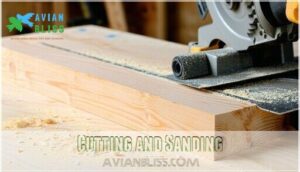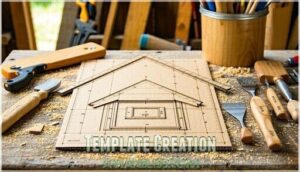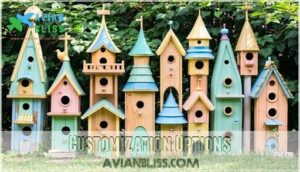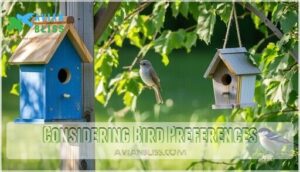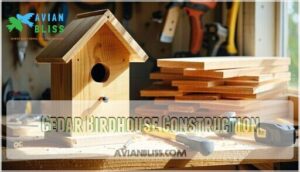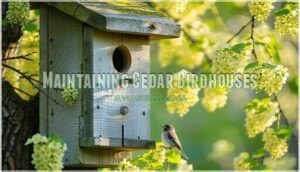This site is supported by our readers. We may earn a commission, at no cost to you, if you purchase through links.

Cedar naturally resists rot, repels insects, and provides excellent insulation without harmful chemicals.
When building, use 3/4-inch cedar boards, cut with proper entrance hole sizes (1-1/4" for chickadees, 1-1/2" for bluebirds).
Don’t sand the interior—birds prefer rough surfaces for climbing.
Always include ventilation holes near the roof and drainage in the floor.
Skip the perch to keep predators away.
A simple coat of linseed oil on the exterior extends life while maintaining that rustic charm.
The secret to attracting the most colorful visitors lies in those precise measurements, using the right materials like cedar to create an ideal environment.
Table Of Contents
- Key Takeaways
- Choosing Cedar Wood
- Building Cedar Birdhouse
- Designing Birdhouse Plans
- Cedar Birdhouse Construction
- Birdhouse Placement Considerations
- Maintaining Cedar Birdhouses
- Frequently Asked Questions (FAQs)
- Will birds live in a cedar birdhouse?
- Is it cheaper to buy or build a birdhouse?
- Can you build a birdhouse out of cedar?
- Should you seal a cedar birdhouse?
- Is cedar okay for a birdhouse?
- Can you make a birdhouse out of cedar?
- Do bluebirds like cedar birdhouses?
- How long will a cedar birdhouse last?
- How do I attract birds to my cedar birdhouse?
- What tools do I need for birdhouse construction?
- Conclusion
Key Takeaways
- You’ll benefit from cedar’s natural properties when building birdhouses, as it repels insects, resists rot, and provides excellent insulation without requiring chemical treatments.
- You should create proper-sized entrance holes (1-1/4" for chickadees, 1-1/2" for bluebirds) and include ventilation near the roof and drainage in the floor, but skip the perch to prevent predator access.
- You’ll need to mount your cedar birdhouse 5-10 feet above ground in a location that offers partial sun exposure and protection from prevailing winds to attract more birds.
- You should perform regular maintenance by cleaning your birdhouse annually with a mild bleach solution, checking for damage twice yearly, and making simple repairs that can significantly extend its 5-7 year lifespan.
Choosing Cedar Wood
You’ll love using cedar wood for your birdhouse because it’s naturally durable and stands up to harsh weather.
Plus, its insect-repelling properties mean your birdhouse won’t become a bug hotel!
Durability and Longevity
Cedar birdhouse plans shine because cedar’s lifespan is impressive, even in tough weather.
It’s naturally durable, weather resistant, and perfect for outdoor conditions.
To boost joint strength, use quality fasteners and consider how finish impacts longevity.
Environmental factors, like sun and rain, won’t easily wear this wood down.
A well-built cedar birdhouse is like a trusty umbrella—it holds up, no matter what nature throws its way!
Rot Resistance
A great reason to trust cedar birdhouse plans is cedar’s natural immunity to rot.
Thanks to its oils, cedar acts like its own little raincoat, resisting moisture effects that cause decay in other woods.
Its reputation as weather-resistant and mildew-resistant keeps your birdhouse standing tall year after year.
One key aspect is to guarantee proper water runoff to protect the structure.
By skipping heavy wood treatments, cedar maintains its charm while ensuring birds live in a safe and long-lasting home.
Insect Repellency
Bug problems? Not with cedar! Its natural oils act as built-in pest control, making your cedar bird house plans a clever choice.
These oils work as insect repellents, keeping damaging pests like carpenter ants and termites away. Unlike other woods, cedar’s natural repellents mean no toxic treatments.
Plus, it’s not just bug repellent—being both rot resistant and mildew resistant makes it incredibly durable. A win-win for you and your feathered guests with natural oils!
Building Cedar Birdhouse
Building a cedar birdhouse is all about precision and patience, but it’s easier than you think.
With the right tools and simple step-by-step cuts, you’ll create a sturdy home birds can count on.
Cutting and Sanding
When cutting cedar wood, accurate cuts are your best friend.
Use a miter saw, table saw, or hand saw for precision.
Sanding techniques matter—smooth edges prevent splintering and keep birds safe.
Focus on edge finishing with fine-grit sandpaper, especially around the entrance hole.
Choosing the right tools ensures clean cuts, making woodworking easier and your birdhouse durable.
Selecting appropriate cedar cutting tools is vital for the project.
Assembly and Construction
When assembling your birdhouse, use glue and nails to secure components, ensuring proper alignment for stability.
Attach the roof carefully, overlapping one piece for weatherproofing. Add a clean-out hatch to the floor with hinges for easy upkeep.
Consider cedar birdhouse kits for simpler construction. Precise birdhouse dimensions and sturdy materials make this woodworking project rewarding.
Take it step by step, and you’ll nail it—literally, with clear instructions!
Finishing and Sealing
When your cedar birdhouse is assembled, it’s time to protect it from Mother Nature.
Cedar brings nature’s own protection—like giving your birdhouse a built-in weatherproof shield for its feathered residents.
Use non-toxic finishes and natural sealants for weather protection.
Consider these options:
- Sealant Types: Choose water-based options to preserve cedar oils.
- Stain Options: Light stains highlight wood grain beautifully.
- Weather Protection: A clear outdoor wood conditioner works wonders.
- Toxicity Concerns: Make certain bird-friendly coatings to keep your feathered tenants safe!
Hanging and Placement
Once sealed, place your birdhouse at the ideal height—5 to 10 feet above ground works best.
Whether it’s on a birdhouse pole or tucked in a birdhouse tree, aim for partial sun exposure and solid weather protection.
To further guarantee safety, consider predator-proof mounting options. Securely mount it to avoid tilting, and think about predator avoidance.
Habitat considerations? Choose a quiet, open area birds will love!
Designing Birdhouse Plans
You’ll get the best results for your feathered visitors when you start with solid birdhouse plans that match each species’ specific needs.
With the right measurements for entrance holes and interior space, you’re not just building a house, you’re creating a cozy cedar home that birds will actually want to raise their families in.
Template Creation
Now that you know your materials, let’s create a template for your cedar bird house plans. Good templates save time and guarantee consistency.
- Print free birdhouse plans from trusted woodworking websites
- Trace designs onto cardboard for reusable patterns
- Download digital templates that can be scaled to desired dimensions
- Use graph paper for creating blueprint customizations
- Take photos of existing birdhouses to inspire plan variations
Material optimization becomes easier when you start with well-designed templates, which is crucial for guarantee consistency and save time.
Customization Options
When it comes to birdhouse design, you’ve got plenty of room to get creative with your cedar bird house plans.
Let your imagination take flight!
| Customization Element | Options to Explore |
|---|---|
| Roof Styles | A-frame, sloped, pagoda, flat |
| Paint Colors | Natural, pastels, bright accents (trim only) |
| Size Variations | Standard, miniature, oversized, double-height |
| Interior Design | Textured walls, multiple perches, divided space |
Mix and match these elements for a multi-compartment masterpiece that reflects your personal style, allowing you to create a unique birdhouse with customization options and a personal touch.
Bluebird Birdhouse Plans
Meticulously designed for these vibrant azure visitors, your bluebird birdhouse plans should follow specific guidelines to attract these desirable songbirds.
Creating a proper bluebird nest box requires attention to detail.
- Entrance hole size: precisely 1½ inches for Eastern Bluebirds
- Nesting box dimensions: 5½" x 4" floor, 8-12" height
- Ventilation and drainage: ¼" holes in floor corners
- Predator baffle design: metal guard on mounting post
- Mounting post options: smooth metal pole 5-6 feet high
Considering Bird Preferences
While bluebird houses need specific dimensions, different bird species have unique preferences that’ll make or break your cedar birdhouse project.
Entrance hole size matters most—bluebirds prefer 2.25-inch openings, while nuthatches squeeze through tiny 1-inch holes.
Interior space should match the species you’re targeting, and mounting height varies too (5-10 feet for bluebirds, just 3 feet to deter sparrows).
Bonus tip: roughen interior surfaces so birds can grip while nesting! Consider using natural cedar materials for insulation and durability.
Cedar Birdhouse Construction
You’ll transform a simple cedar board into a perfect bird sanctuary with just a few cuts, some nails, and a bit of planning.
Cedar’s natural properties make it the ideal wood choice for your feathered friends’ new home, keeping them cozy through rain, snow, and summer heat without warping or rotting like other woods might, due to its natural properties.
Measuring and Marking Cuts
Now that you’ve got your design, it’s time to grab your pencil and ruler! Mark your cedar fence picket with accurate dimensions, following the wood grain for strength.
You’ll need to note cutting angles clearly – a miter box or miter saw helps with those 45-degree roof cuts.
Circle any knots or splits in the cedar picket and adjust your layout to avoid these defects. Considering species specific requirements is essential for attracting the desired birds.
Good marking saves headaches later, and following these steps ensures a well-planned and successful project.
Assembling Components
The assembly phase transforms your pile of cedar pieces into a cozy avian retreat.
Start by dry-fitting components to confirm proper alignment techniques before applying wood glue to joints.
Secure side walls to back pieces using brads or small nails, being careful not to split the wood.
During birdhouse construction, maintain square corners with clamps while the glue sets, and you’ll feel a sense of accomplishment watching your birdhouse take shape!
Securing Roof and Floor
Now that all components are ready, let’s secure your roof and floor.
These elements protect birds from predators and weather.
For a perfect cedar roof and floor installation:
- Create a small roof overhang (about 1/2") for rain runoff protection
- Add 1/8" floor drainage gaps on each side for nest health
- Install simple hinge mechanisms using pivot nails for easy cleaning
- Apply weather sealing at roof attachment points without blocking ventilation
Use wood glue sparingly with secure fasteners for your roof assembly.
Birds will thank you for a well-secured roof!
Adding Entrance Hole and Perch
Carefully drill your entrance hole on the front panel of your birdhouse, as this small opening will become your feathered friend’s front door. Use a hole saw for clean edges that won’t hurt tiny bird feet.
You can find the right birdhouse hole saw at online retailers.
| Bird Species | Ideal Hole Size | Recommended Perch Placement |
|---|---|---|
| Bluebird | 1½ inches | None needed |
| Chickadee | 1¼ inches | 1 inch below hole |
| Wren | 1⅛ inches | Optional |
| Nuthatch | 1¼ inches | None needed |
| Sparrow | 1½ inches | 2 inches below hole |
While many traditional designs include perches, modern birdhouse plans often skip them as they mainly help predators. If you add one, use cedar or a small dowel, and consider the ideal hole size for your bird species to ensure a safe and welcoming environment.
Birdhouse Placement Considerations
You’ll need to find the perfect spot for your cedar birdhouse where it’s safe from predators but still visible to your feathered friends.
The right placement, about 5-10 feet high and facing away from prevailing winds, can make the difference between an empty nest box and a bustling bird nursery where you can enjoy watching your new neighbors raise their families.
Mounting Mechanisms
Now that your cedar birdhouse is built, you’ll need to decide how to mount it.
You’ve got several hanging options to choose from: pole mounting keeps predators at bay, tree attachment blends with nature, and wall mounting offers easy accessibility.
Simple birdhouse hooks or wires work well for basic mounting options. Sturdy bracket designs prevent tipping in wind.
Whatever mounting mechanism you choose, make certain it’s secure enough to withstand weather and curious wildlife.
Drainage and Moisture Control
Beyond securing your birdhouse properly, keeping it moisture-free is just as important. Water is the enemy of even rot-resistant cedar.
To guarantee proper birdhouse drainage and prevent moisture issues:
- Drill 1/4-inch ventilation holes near the top corners for airflow
- Create small bottom gaps (1/8-inch) so water can escape
- Add a 2-inch roof overhang to shield the entrance
- Design a slightly sloped floor that tilts forward for natural runoff
Predator Protection
Predators can turn your carefully crafted cedar haven into a nightmare for nesting birds. You’ll need effective protection strategies to keep your feathered friends safe.
Here’s a quick reference guide for predator-proofing your birdhouse:
| Predator Type | Protection Method | Effectiveness |
|---|---|---|
| Climbing (squirrels, snakes) | Squirrel baffle, metal pole mounting | High |
| Birds (hawks, jays) | Proper entrance size, extended entry tube | Medium |
| Raccoons/cats | Wire mesh guards, high placement | Very high |
| Insects/parasites | Cedar wood natural repellency | Moderate |
| Weather-related | Metal predator guards, overhang design | High |
Remember, location matters! Mount birdhouses at least 5-6 feet high and away from branches that predators could use as launching pads.
Attracting Birds to Your Yard
Now that your birdhouse is safe from predators, let’s make your yard a bird paradise! Create a bird-friendly corner with multiple feeders offering sunflower seeds, thistle, and suet.
Add a water source with moving features—birds love the sound of bubbling water! Plant native trees and shrubs for shelter and food.
Your cedar birdhouse will attract more visitors when surrounded by these yard safety elements and natural nesting materials.
Maintaining Cedar Birdhouses
You’ll need to check your cedar birdhouses twice yearly for damage and buildup, just like birds do a little spring cleaning before nesting season.
With simple tools and a quick inspection, you can keep these natural homes in top shape for years, ensuring your feathered neighbors return season after season to raise their families, and thus providing them a safe nesting place.
Cleaning and Disinfecting
Now that your birdhouse is properly positioned, let’s talk about keeping it clean for healthy bird families.
Regular maintenance prevents diseases that can harm your feathered tenants.
Clean your cedar birdhouse annually with these simple steps:
- Remove old nests completely (wear gloves for parasite control)
- Scrub interior with a 9:1 water-bleach solution (safe disinfectants only!)
- Rinse thoroughly and allow to dry fully to prevent mold
- Check drainage holes for blockages that trap moisture
Repairing and Replacing Parts
Now that your birdhouse is squeaky clean, let’s talk about keeping it in tip-top shape. Even with cedar’s durability, parts will need attention over time.
You’ll be surprised how simple repairs can extend your birdhouse’s lifespan!
| Common Issue | Quick Fix |
|---|---|
| Roof Replacement | Remove old fasteners, cut new cedar piece to size |
| Floor Repair | Sand damaged areas, apply wood preservative |
| Wall Patches | Fill holes with cedar plugs, secure with waterproof glue |
| Hinge Maintenance | Oil moving parts, replace rusted screws |
| Fastener Corrosion | Swap with stainless steel alternatives |
These repairs are straightforward and can significantly improve the birdhouse’s condition, making it a safe and welcoming space for birds, which is the ultimate goal of birdhouse maintenance and ensuring a long durability.
Regular Inspections
Just as you fixed those loose boards, don’t forget to check your birdhouse regularly.
Inspect your cedar creation every two months to catch small issues before they become big problems. Look at the cedar roof for damage, test the structural integrity of walls, and check for pest intrusion.
- Damage assessment takes just five minutes but can add years to your birdhouse’s life
- Remove old nests during inspection to prevent parasite buildup and disease
- Monitor entry holes for enlargement from squirrels or woodpeckers that compromise weatherproofing
Seasonal Preparations
With winter approaching, prep your cedar birdhouse to weather the cold months ahead.
Remove old nesting material during fall maintenance, apply weatherproof sealant to joints (avoiding the entrance hole), and check for loose parts.
Before spring cleaning, install predator guards for the upcoming nesting season.
During summer, monitor for overheating issues.
Your simple seasonal care routine guarantees birds return year after year to your climate-resistant home.
Frequently Asked Questions (FAQs)
Will birds live in a cedar birdhouse?
While artificial homes seem unlikely sanctuaries, birds absolutely love cedar birdhouses.
You’ll find them enthusiastically nesting in your cedar creation, as this wood’s natural oils repel insects and resist decay, creating a perfect home.
Is it cheaper to buy or build a birdhouse?
You’ll typically save money building your own birdhouse rather than buying one. With basic tools and a $10-15 cedar fence picket, you can create what would cost $25-40 in stores.
Can you build a birdhouse out of cedar?
By the gods of Mount Olympus!
You can absolutely build a birdhouse out of cedar.
It’s actually ideal because cedar’s natural oils resist rot and insects, and you’ll only need one 1×6 cedar picket to complete it.
Should you seal a cedar birdhouse?
You don’t need to seal cedar birdhouses.
Cedar naturally resists rot, insects, and weather damage.
Leave it unfinished for birds’ safety, as sealants may contain harmful chemicals.
The wood will age to a lovely silver-gray over time.
Is cedar okay for a birdhouse?
Cedar’s naturally rot-resistant properties make it ideal for birdhouses.
You’ll appreciate its durability against weather elements and insects.
Birds enjoy its non-toxic nature, and you won’t need chemical treatments that might harm your feathered visitors.
Can you make a birdhouse out of cedar?
To put it simply, yes! You can absolutely make a birdhouse using cedar.
It’s durable, naturally weather-resistant, and you don’t need to treat it with chemicals that might harm your feathered friends.
Do bluebirds like cedar birdhouses?
Yes, bluebirds absolutely love cedar birdhouses.
You’ll find these beautiful birds happily nesting in your cedar creation.
The natural oils in cedar repel insects and resist decay, making it their perfect home.
How long will a cedar birdhouse last?
With proper maintenance, your cedar birdhouse will last 5-7 years outdoors, thanks to cedar’s natural rot resistance.
You’ll get even longer life by applying a protective finish and mounting it in a partially sheltered location.
How do I attract birds to my cedar birdhouse?
Like a magnet draws metal, attract birds by placing your birdhouse in a quiet spot with nearby trees.
Filling feeders with seeds, and providing fresh water.
Don’t forget to maintain cleanliness for your feathered visitors.
What tools do I need for birdhouse construction?
You’ll need a saw, drill with spade bits, hammer, measuring tape, square, and pencil.
Don’t forget wood glue, galvanized nails, and clamps.
Sandpaper helps create splinter-free homes for your feathered friends.
Conclusion
Birds of a feather flock together, especially when they spot your handcrafted cedar bird house.
With these cedar bird house plans, you’ve created more than just shelter—you’ve built a legacy that’ll last through countless seasons.
Remember, it’s the thoughtful details that make all the difference: proper ventilation, predator protection, and that natural cedar aroma birds adore.
Your feathered neighbors will thank you with their cheerful presence and song year after year, filling the air with joyful melodies.


